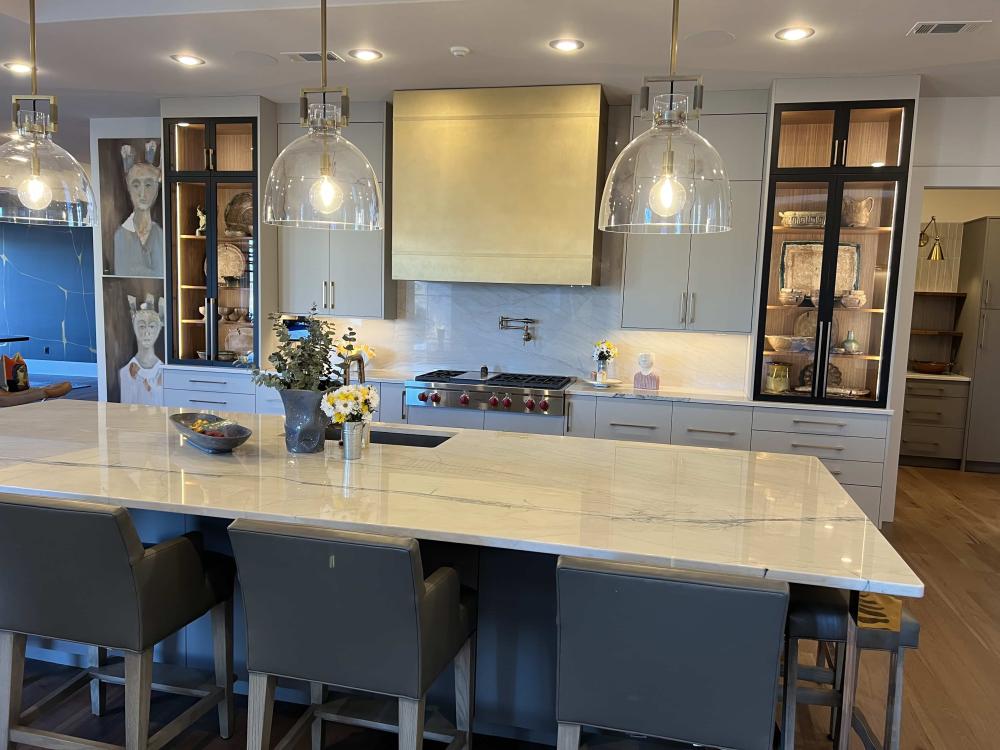A transitional style kitchen combines the best of both worlds, blending the warmth and elegance of traditional designs with the clean lines and functionality of contemporary aesthetics. With its harmonious balance of classic charm and modern sensibility, a transitional style kitchen layout creates a space that feels inviting yet refined, offering an atmosphere of understated luxury.
What Is the Difference Between Traditional and Transitional Kitchens?

When comparing traditional and transitional kitchens, the key differences lie in the overall design elements. Traditional kitchens often feature intricate details, ornate cabinetry, and heavy woodwork, drawing from a more classical, historic design. They tend to use rich, dark colors and elaborate moldings, creating a stately and grand atmosphere.
In contrast, transitional style kitchens embrace the simplicity and elegance of both traditional and contemporary styles. While still maintaining the warmth and comfort of traditional kitchens, transitional designs are streamlined, with more subtle detailing and softer, neutral color palettes.
What Home Styles Pair Well With a Transitional Kitchen?
A transitional kitchen pairs beautifully with various architectural and interior design styles. It complements Colonial Revival homes by adding warmth while maintaining sophistication.
Craftsman homes, with their handcrafted details and natural materials, also harmonize well with transitional designs. Its versatility also allows it to enhance contemporary homes, offering a timeless appeal that elevates the home’s luxury without being trendy.
Integrating a transitional style kitchen enhances a home’s value, making it a perfect choice for homeowners looking to create a luxurious, enduring kitchen that stands out without being overly trendy.
What Are Some Design Features That Define Transitional Kitchen Designs?
Transitional kitchen designs strike a perfect balance between traditional charm and modern sensibility, creating a timeless look that draws from the rich history of kitchens. Over time, the evolution of kitchen design has changed, and the history of kitchen designs has transitioned into the refined styles we know and love today.
Transitional kitchen designs are defined by their ability to blend the best features of traditional and contemporary styles. Here are a few key design elements that set them apart:
Cabinetry & Countertops
Cabinetry in a transitional style kitchen often features clean lines and subtle detailing. Think of light-stained wood, or sleek, painted finishes that combine with elegant, premium countertops made from quartz, marble, or granite. Mixed materials, such as pairing wood with metal or stone, are also common in transitional kitchen designs, offering visual interest and texture.
Sinks & Faucets
For sinks and faucets, a transitional kitchen often incorporates high-end pieces that bring artisan craftsmanship into play. Farmhouse or apron-front sinks combine beautifully with polished faucets, blending both traditional and contemporary materials for a seamless look.
Range Hoods & Lighting

Custom kitchen range hoods provide a striking focal point, combining metal finishes such as copper and stainless steel with intricate craftsmanship. These hoods are functional while also enhancing the visual appeal of the space.
Complementing lighting, such as pendant lights with metal accents, adds to the ambiance, ensuring the kitchen feels both stylish and inviting.
Create Your Custom Transitional Style Kitchen with CopperSmith
A transitional style kitchen offers endless possibilities for creating a space that is both luxurious and timeless. To truly elevate your kitchen, consider incorporating CopperSmith’s premium products, such as custom kitchen hoods, farmhouse sinks, and high-end materials. Contact CopperSmith today and learn how we can help you design the perfect transitional kitchen tailored to your unique needs and taste.
